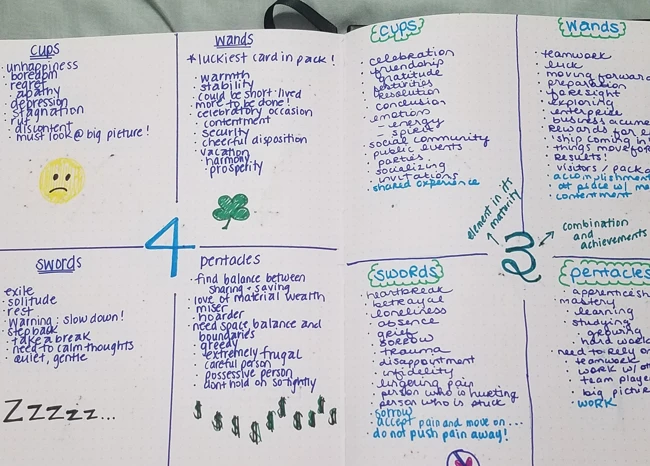Are you looking for a unique and enlightening way to explore your inner thoughts and emotions? Look no further than tarot cards for daily journaling prompts. Tarot cards can serve as a powerful tool for self-reflection, goal setting, emotional healing, relationship insights, and creative inspiration. In this article, we will guide you through the process of using tarot cards as journaling prompts, providing step-by-step instructions, tips for interpretation, and sample prompts to get you started. So grab your favorite tarot deck and a journal, and let’s embark on a journey of self-discovery and personal growth.
Contents
- Benefits of Using Tarot Cards for Daily Journaling
- Getting Started: Choosing the Right Tarot Deck
- Using Tarot Cards as Daily Journaling Prompts
- How to Interpret Tarot Cards for Journaling
- Sample Daily Journaling Prompts Using Tarot Cards
- Tips for Effective Tarot-Enhanced Journaling
- Journaling Rituals and Tarot
- Conclusion
- Frequently Asked Questions
- References
Benefits of Using Tarot Cards for Daily Journaling
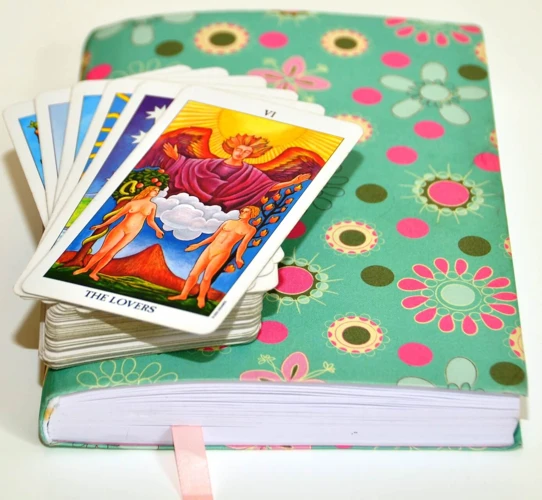
Using tarot cards for daily journaling offers a plethora of benefits that can enhance your personal growth and introspection. One of the main advantages is that tarot cards serve as powerful prompts for self-reflection. By drawing a card each day, you are provided with a specific focus or theme to explore in your journal. These prompts can help you delve deep into your thoughts, emotions, and experiences, offering a deeper understanding of yourself. Additionally, tarot cards can act as catalysts for goal-setting. The symbolic imagery and messages within the cards can guide you in clarifying your desires and aspirations, allowing you to set meaningful and achievable goals. Tarot cards can aid in emotional healing. They provide a safe and supportive space to explore and process your emotions. Journaling about the guidance and insights gained from tarot cards can help you uncover patterns, release emotional blocks, and promote healing and growth. Tarot cards also offer valuable insights into relationships. By using the cards as prompts, you can gain a fresh perspective on your relationships and uncover hidden dynamics or patterns. This can aid in fostering healthier connections and resolving conflicts. Finally, tarot cards can ignite your creative inspiration. The rich symbolism and imagery within the cards can stimulate your imagination and spark new ideas for artistic endeavors. By incorporating tarot cards into your daily journaling practice, you can tap into your creativity and find fresh perspectives. With all these benefits, it’s no wonder why tarot-enhanced journaling is gaining popularity among those seeking self-discovery and personal development. So, whether you are new to tarot or a seasoned practitioner, incorporating tarot cards into your daily journaling can be a transformative experience.
Getting Started: Choosing the Right Tarot Deck
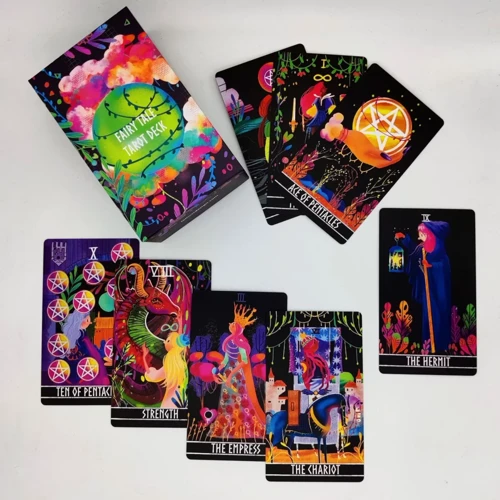
Choosing the right tarot deck is a crucial step in starting your tarot-enhanced journaling practice. With the vast array of tarot decks available, finding one that resonates with you is essential. When selecting a tarot deck, consider your personal preferences and intuitive connection. Pay attention to the artwork, imagery, and overall theme of the deck. Some decks have traditional symbolism, while others take a more modern or abstract approach. Trust your instincts and choose a deck that speaks to you on a visual and energetic level. If you’re a beginner, it may be helpful to start with a popular and widely used deck, such as the Rider-Waite-Smith deck. This deck is known for its clear symbolism and comprehensive guidebooks, making it ideal for beginners. However, feel free to explore different decks that reflect your interests and resonate with your intuition. Remember, there is no right or wrong deck to choose. It’s all about finding the one that sparks a connection and inspires you. Once you have selected your tarot deck, take some time to familiarize yourself with the cards. Study their meanings and symbolism using guidebooks or online resources. Work with each card individually to deepen your understanding. This initial process of choosing a tarot deck is an important foundation for your tarot-enhanced journaling practice, as it sets the tone for your personal connection with the cards. So take your time, trust your intuition, and select a tarot deck that resonates with you on a deep and meaningful level.
Using Tarot Cards as Daily Journaling Prompts
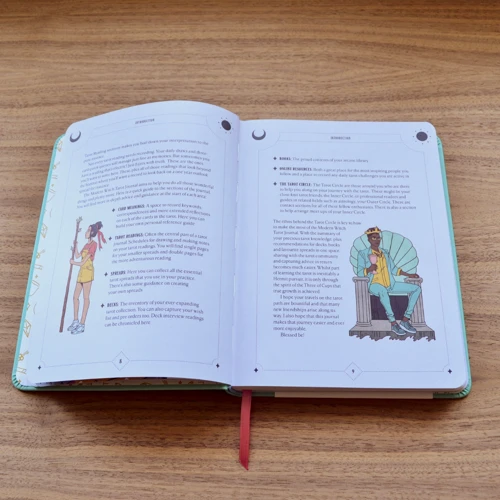
Using tarot cards as daily journaling prompts is a simple and effective way to gain insight, explore your thoughts, and tap into your intuition. Here’s how you can incorporate tarot cards into your journaling practice:
1. Set aside dedicated time: Find a quiet and comfortable space where you can focus on your journaling practice. Set aside specific time each day to draw a tarot card and reflect on its message.
2. Choose a tarot deck: Select a tarot deck that resonates with you. There are numerous decks available, each with its own unique artwork and symbolism. Choose one that speaks to you personally and captures your imagination.
3. Shuffle and draw a card: Begin by shuffling the tarot deck while focusing on your intention for the journaling session. When you feel ready, draw a card at random and place it in front of you.
4. Reflect on the card’s imagery and symbolism: Take a few moments to study the card’s imagery, colors, and symbols. Pay attention to your initial thoughts and feelings when you observe the card. Note any connections or insights that arise.
5. Journal your thoughts: Open your journal and begin writing about the card’s message and how it relates to your current experiences or emotions. Allow your thoughts to flow freely onto the pages, without judgment or self-editing. Write about any revelations, questions, or struggles that arise.
6. Explore the card’s meaning: Refer to a tarot guidebook or online resources to delve deeper into the card’s meaning. Consider the traditional interpretations, but also trust your intuition and personal associations with the symbolism.
7. Connect the card to your life: Reflect on how the card’s message applies to your life or the specific area you want to explore. Write about any patterns or insights you discover. This process can help you gain clarity and guidance.
8. End with gratitude: Before closing your journaling session, express gratitude for the wisdom and insights gained from the tarot card. Thank the universe, your intuition, or any higher power you believe in.
By incorporating tarot cards as daily journaling prompts, you invite a deeper level of self-reflection, self-awareness, and personal growth into your life. Whether you are new to tarot or an experienced practitioner, this practice offers a valuable tool for self-discovery. So grab your tarot deck, open your journal, and embark on a journey of exploration and understanding. For more tips on tarot journaling, check out our article on Tarot Journaling Tips for Beginners.
How to Interpret Tarot Cards for Journaling
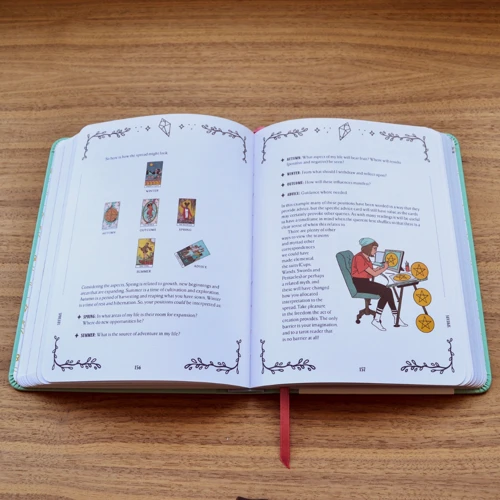
When it comes to interpreting tarot cards for journaling, there are a few key steps to follow. First, take a moment to familiarize yourself with the imagery and symbolism of the card you have drawn. Pay attention to the colors, objects, and figures depicted, as well as any emotions or impressions they evoke. Consider the traditional meanings associated with the card, but also trust your own intuition and personal connection to the image.
Next, consider the context of the card within your own life. Reflect on the specific area of your life or theme you are exploring in your journal. How does the card’s symbolism relate to your current situation? What messages or insights does it offer regarding your emotions, thoughts, or actions?
Another helpful technique is to journal a free-flowing stream of consciousness in response to the card. Write down any thoughts, feelings, or memories that arise as you gaze at the card. Don’t worry about making coherent sentences; simply allow the imagery to guide your pen and let your subconscious speak through your words.
It can also be beneficial to ask yourself specific questions related to the card’s meaning. For example, if the card represents love or relationships, you might ask yourself, “How am I currently experiencing love in my life?” or “What can I do to nurture my relationships?”
Finally, don’t forget to capture any personal insights, a-ha moments, or action steps that arise from your interpretation of the card. These can be valuable takeaways to reflect upon and implement in your daily life.
Remember, there is no right or wrong way to interpret tarot cards for journaling. It’s a deeply personal practice, and every individual will have their own unique insights and experiences. If you’re looking for further guidance, consider seeking resources on tarot journaling techniques or exploring emotional exploration through tarot journaling to deepen your practice.
Sample Daily Journaling Prompts Using Tarot Cards
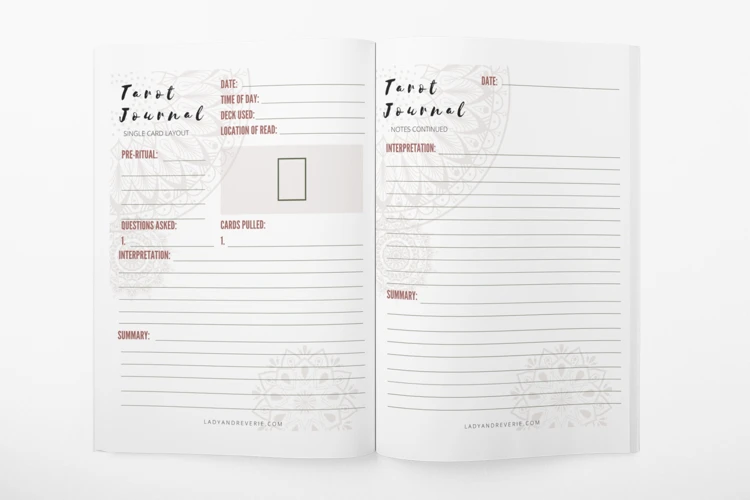
When it comes to using tarot cards for daily journaling, the possibilities for prompts are endless. Here are a few sample journaling prompts that can help you explore different aspects of your life and inner world. One prompt is to engage in self-reflection by asking, “What do I need to know about myself right now?” Drawing a card and journaling about the insights gained can lead to a deeper understanding of your emotions, behaviors, and desires. Another prompt focuses on goal setting, such as “What steps can I take to manifest my dreams?” This prompt aligns with the goal-setting benefits of tarot-enhanced journaling and can help you gain clarity on your desires and create a plan of action. To dive into emotional healing, a prompt like “What is blocking my emotional growth?” can reveal hidden barriers and guide you towards releasing emotional blocks and fostering personal growth. Exploring relationship insights can be done by asking, “What can I learn from my current relationships?” This prompt encourages you to reflect on the dynamics of your relationships and gain insights into areas of growth and improvement. Lastly, for creative inspiration, a prompt like “What message does the universe have for my creative endeavors?” can spark new ideas and provide inspiration for artistic projects. These sample prompts are just a starting point, and you can adapt and create your own prompts based on your specific needs and areas of exploration. Journaling with tarot cards allows you to tap into your intuition, gain valuable insights, and unlock the potential for personal growth and transformation. So grab your favorite tarot deck, choose a prompt, and let your journaling journey begin.
Prompt 1: Self-Reflection
Prompt 1: Self-Reflection
Self-reflection is a powerful tool for personal growth and understanding oneself on a deeper level. Using tarot cards as prompts for self-reflection can provide valuable insights and guidance. To begin, select a tarot card from your deck and place it in front of you. Take a few moments to observe the card’s imagery, symbols, and colors. Then, ask yourself questions related to the card and its meanings. How does this card resonate with you? What aspects of your life does it symbolize? How can you apply the messages of this card to your current situation? Allow yourself to delve into your thoughts and emotions as you journal about these questions. You may discover hidden aspects of yourself, gain clarity on your desires or fears, or unearth subconscious patterns that influence your actions. Self-reflection through tarot journaling can also help you identify areas for personal growth and development. For example, if you draw a card that represents strength, you may reflect on how you can embody that strength in challenging situations. Alternatively, if you draw a card that signifies transformation, you can explore the areas of your life where you are ready for change. Through this process, you can gain a deeper understanding of yourself and make empowered choices for your personal evolution. Self-reflection prompts using tarot cards provide a unique and dynamic approach to journaling, allowing you to tap into your intuition and explore the depths of your being. As you explore the world of self-reflection through tarot journaling, you can develop a greater sense of self-awareness and create a more fulfilling life. For more insights on exploring emotions through tarot journaling, check out our guide on exploring emotions with tarot journaling. If you’re interested in establishing a ritual for your tarot journaling practice, be sure to read our article on creating a tarot journal ritual.
Prompt 2: Goal Setting
When using tarot cards for goal setting in your daily journaling practice, the cards can provide valuable insights and guidance. Here’s how you can incorporate tarot cards into your goal setting process:
- Select a Card: Begin by shuffling your tarot deck and focusing on your goal or intention. As you shuffle, ask the cards to guide you towards the most relevant insight for your goal.
- Draw a Card: Once you feel ready, draw a single card from the shuffled deck. This card will represent the energy, message, or lesson that can support you in achieving your goal.
- Reflect on the Card: Take a moment to study the imagery, symbols, and overall message of the card. Consider how it relates to your goal and what it might be trying to communicate to you.
- Journal Your Insights: In your journal, write down the card you drew and your initial impressions. Reflect on the specific aspects of the card that resonate with your goal. Use the card as a springboard for exploring your desires, motivations, and any potential obstacles.
- Set Action Steps: Based on the insights gained from the tarot card, write down specific action steps or strategies that will help you work towards your goal. The card may offer suggestions, highlight areas for growth, or prompt you to approach your goal from a different perspective.
- Repeat the Process: If desired, you can repeat this goal-setting practice with different cards and different goals. Each card will offer unique insights and perspectives that contribute to your overall growth and progress.
Using tarot cards as prompts for goal setting adds a layer of depth and intuition to the process. It helps you tap into your subconscious desires and receive guidance from a higher source. By combining tarot wisdom with journaling, you create a powerful tool for manifestation and personal transformation. So, grab your tarot deck, set your intentions, and let the cards guide you towards achieving your goals.
Prompt 3: Emotional Healing
Prompt 3: Emotional Healing
Tarot cards can be a powerful tool for emotional healing. When using tarot cards as journaling prompts, they can assist in uncovering and processing deep-seated emotions. To begin with, start by shuffling the deck and focusing on your emotional well-being. Draw a card, and allow its imagery and symbolism to resonate with you. Pay attention to any emotions or memories that arise as you observe the card.
Next, take out your journal and reflect on the card’s message in relation to your emotional state. Ask yourself questions such as: What emotions am I currently experiencing? Are there any recurring patterns or triggers? How can I heal and release these emotions?
Write down your observations and thoughts, using the tarot card as a guide. Jot down any insights or revelations that come to you during this process. This journaling practice allows you to create a safe and supportive space to explore your emotions and understand their underlying causes.
As you continue to use tarot cards for emotional healing, you may notice shifts in your awareness and a release of pent-up emotions. This practice can serve as a powerful tool for self-discovery and personal growth, as it helps you gain clarity on emotional blockages and guides you towards healing and transformation.
Remember, when using tarot cards for emotional healing, it’s important to approach the process with self-compassion and an open mind. Be patient with yourself and allow the insights gained from the cards to support your healing journey.
To further enhance your tarot-enhanced journaling practice, consider incorporating rituals or mindfulness techniques. These can help create a sacred space and deepen your connection with the cards and your emotions. You can explore rituals such as grounding exercises, meditation, or lighting candles to create a calming atmosphere. Find what resonates with you and integrate it into your journaling routine.
Incorporating tarot cards into your daily journaling for emotional healing can be a transformative experience. It allows you to tap into your inner world, gain insights, and take steps towards healing and growth. So, grab your journal and tarot deck, and embark on a journey of emotional exploration and healing.
Prompt 4: Relationship Insights
When using tarot cards for relationship insights, the deck can offer a fresh perspective on your connections with others. Draw a card and reflect on how it relates to a specific relationship you want insights on. Consider the symbolism, imagery, and traditional meanings associated with the card. Here are a few examples of how tarot cards can provide relationship insights:
1. The Lovers (Major Arcana): This card symbolizes unity, partnership, and harmony. If drawn for a relationship, it suggests a strong bond and deep connection between two individuals. It can indicate a time of growth and mutual support within the relationship.
2. Two of Cups (Minor Arcana): This card represents love, emotional connection, and a balanced partnership. If drawn, it may indicate a new romantic relationship or the strengthening of an existing one. It signifies mutual understanding, trust, and a harmonious connection between two individuals.
3. Three of Pentacles (Minor Arcana): This card signifies collaboration, teamwork, and cooperation. In the context of relationships, it suggests the importance of working together and building a solid foundation. It may symbolize a relationship where both parties need to put in effort and communicate effectively to achieve shared goals.
Remember, tarot cards are tools for self-reflection, and their interpretations may vary based on the reader’s intuition and personal experiences. Allow your intuition to guide you as you explore the relationship insights provided by the cards. With each card drawn, you can gain valuable insights into the dynamics, challenges, and potential growth within your relationships.
References:
– Tarot Journaling Tips for Beginners
Prompt 5: Creative Inspiration
Prompt 5: Creative Inspiration
Tarot cards are not just a tool for introspection and self-reflection; they can also be a powerful source of creative inspiration. Drawing a card as a daily prompt can ignite your imagination and help you tap into your artistic potential.
1. Imagery and Symbolism: Each tarot card is rich in intricate imagery and symbolism. By studying the artwork and contemplating the symbolism within a chosen card, you can gain new perspectives and insights that can fuel your creativity. Pay attention to the colors, objects, and figures depicted in the card. Journal about what emotions or ideas are evoked by these elements and how they relate to your creative pursuits.
2. Storytelling: Tarot cards often tell stories, whether they represent a specific event, archetype, or journey. Use the card as a starting point for storytelling or writing exercises. Let the characters and scenes in the card inspire you to create narratives, poems, or even fictional worlds. Write about what you imagine could be happening beyond the borders of the card and explore the themes and emotions that arise.
3. Collage and Visual Art: If you enjoy working with visuals, consider using tarot cards as a foundation for collage art or mixed media projects. Cut out images from different cards and combine them to create new compositions. Incorporate other materials such as paint, stamps, or found objects to bring your artistic vision to life. Let the cards guide the colors, themes, and overall aesthetic of your piece.
4. Music and Dance: Tarot cards can also inspire musical compositions or dance routines. Choose a card that resonates with you and listen to music that you feel encapsulates its energy. Allow the melodies, rhythms, and lyrics to inspire your own compositions or improvisations. Similarly, let the movements and gestures depicted in the card guide your dance practice, exploring new ways of expressing yourself.
Remember, there are no right or wrong answers when it comes to tarot-enhanced creative inspiration. The aim is to allow the cards to stimulate your imagination and unlock hidden depths of your artistic potential. Embrace the unpredictability and playfulness of this process, allowing the cards to lead you on exciting and uncharted creative ventures.
Tips for Effective Tarot-Enhanced Journaling
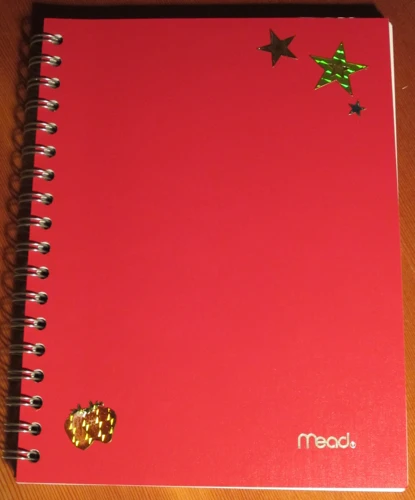
When it comes to effective tarot-enhanced journaling, there are a few key tips to keep in mind. First, create a sacred and focused space for your journaling practice. Find a quiet corner of your home or set up a special altar where you can sit undisturbed and connect with your tarot cards. This dedicated space will help you cultivate a sense of intention and focus. Next, establish a consistent journaling routine. Set aside a specific time each day to draw a card and reflect on its message in your journal. Consistency will deepen your connection with the cards and allow for a more meaningful exploration of the prompts. As you journal, be open and receptive to the messages and insights that come through the cards. Trust your intuition and let your thoughts and emotions flow freely onto the pages of your journal. Remember, there are no right or wrong interpretations—what matters is the personal meaning you find in the cards. It can also be helpful to keep a tarot journal where you record your card draws, insights, and reflections. This allows you to track your progress, revisit past readings, and spot recurring themes or patterns. Additionally, don’t be afraid to experiment and get creative with your journaling practice. Try combining tarot with other journaling techniques, such as free writing, guided prompts, or visual art. Explore different spreads or layouts to deepen your understanding of the cards and their influences. Lastly, be gentle with yourself throughout the process. Journaling with tarot is a personal journey, and it’s essential to approach it with self-compassion and patience. Embrace the process of self-discovery and enjoy the unique insights and growth that come from integrating tarot and journaling. By following these tips, you can create a transformative and enriching tarot-enhanced journaling practice that supports your personal growth and self-reflection.
Journaling Rituals and Tarot
Journaling rituals can greatly enhance your tarot practice and provide a sense of structure and intention to your daily journaling. Here are a few ideas for incorporating rituals into your tarot-enhanced journaling:
1. Cleansing and Clearing: Before beginning your journaling session, take a moment to cleanse and clear your energy. You can do this by smudging with sage, lighting incense, or simply taking a few deep breaths to center yourself. This helps create a sacred space for your journaling practice.
2. Grounding and Centering: Grounding yourself before diving into journaling can help you connect with the cards on a deeper level. You can practice grounding by visualizing roots growing from your feet into the earth or by doing a short meditation to center your energy.
3. Card Selection Ritual: To choose a tarot card for your daily journaling prompt, you can incorporate a ritual into the process. Shuffle the cards mindfully while focusing on your intention for the journaling session. Ask a question or set an intention, then draw a card and reflect on its meaning in relation to your inquiry.
4. Visualization Exercise: Before journaling, spend a few moments visualizing the energy of the tarot card you pulled. Close your eyes and imagine yourself stepping into the card and experiencing its imagery and symbolism. This exercise can help you connect more deeply with the card’s message and enhance your journaling experience.
5. Gratitude Practice: Cultivating gratitude can be a powerful addition to your journaling ritual. Begin by expressing gratitude for the opportunity to work with tarot cards and engage in self-reflection. Take a moment to express appreciation for the insights you have gained and the growth you have experienced through your journaling practice.
Remember, these rituals are meant to enhance your experience, so feel free to adapt and personalize them to suit your preferences and beliefs. By incorporating these rituals into your tarot-enhanced journaling practice, you can create a sacred and intentional space for self-exploration and personal growth.
Conclusion
In conclusion, incorporating tarot cards into your daily journaling practice can be a powerful tool for self-discovery and personal growth. The benefits of using tarot cards as journaling prompts are vast. They provide a focused theme for self-reflection, aid in goal-setting, promote emotional healing, offer relationship insights, and ignite creative inspiration. By using tarot cards in your journaling practice, you open yourself up to a deeper understanding of yourself, your goals, and your relationships. The symbolism and imagery within the cards serve as a guide, offering valuable insights and prompting deep introspection. Whether you are a beginner or an experienced tarot practitioner, tarot-enhanced journaling can be a transformative and enlightening practice. So grab your favorite tarot deck, open your journal, and embark on a journey of self-discovery and personal growth through the power of tarot cards. With consistent practice, you may find that this combination of tarot and journaling becomes an essential part of your daily routine, providing you with valuable guidance and a deeper connection to your inner world.
Frequently Asked Questions
FAQs about Using Tarot Cards for Daily Journaling
1. Can anyone use tarot cards for daily journaling?
Absolutely! Tarot cards can be used by anyone, regardless of their level of experience or knowledge in tarot. It’s a personal and introspective practice that anyone can benefit from.
2. Do I need a special tarot deck for journaling?
You don’t need a special deck specifically for journaling. You can use any tarot deck that resonates with you and speaks to your intuition. Choose a deck that visually appeals to you and feels comfortable to work with.
3. How many tarot cards should I draw for my daily prompt?
You can draw just one card for your daily prompt. One card can provide plenty of guidance for reflection. However, if you prefer a more in-depth exploration, you can draw multiple cards or even use a tarot spread specifically designed for journaling.
4. What if I don’t understand the meaning of the tarot card?
If you’re unsure about the meaning of a tarot card, you can refer to the guidebook that comes with your deck. However, it’s important to remember that the interpretation of the card is subjective. Trust your intuition and allow the card’s symbolism and energy to guide your journaling process.
5. How do tarot cards help with goal setting?
Tarot cards can assist in goal setting by providing insights and guidance. The cards can help you clarify your desires, identify obstacles, and suggest actionable steps to achieve your goals. They act as powerful prompts to explore your aspirations and create a path towards their realization.
6. Can tarot cards reveal future events through journaling?
Tarot cards are not fortune-telling tools, but rather tools for self-reflection and exploration. They can provide insights into current situations and offer guidance for personal growth. Journaling with tarot cards focuses on understanding yourself better and making empowered choices in the present moment.
7. How often should I journal with tarot cards?
The frequency of journaling with tarot cards depends on your personal preference and available time. Some people prefer to journal daily, while others find a weekly or monthly practice more manageable. Experiment with different frequencies and find what works best for you.
8. Can I use tarot cards for emotional healing?
Yes! Tarot cards can be a powerful tool for emotional healing. By exploring the themes and symbolism of the cards, you can gain insights into your emotions, process past experiences, and develop a deeper understanding of yourself. Journaling with tarot cards can be a cathartic and transformative practice.
9. Should I follow a specific journaling structure when using tarot cards?
There’s no right or wrong way to journal with tarot cards. Feel free to create your own structure and adapt it to your needs. Some may prefer to write freely based on the card’s prompt, while others may follow a more structured approach, incorporating reflection questions or spreads.
10. Can tarot-enhanced journaling be incorporated into a ritual?
Absolutely! Many people find it beneficial to incorporate a small ritual into their tarot-enhanced journaling practice. Lighting a candle, grounding oneself, or setting an intention before drawing a card can create a sacred and focused space for deeper exploration.
